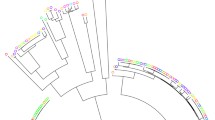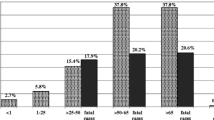Abstract
Despite the importance of the Enterobacter cloacae complex as a nosocomial pathogen, little is known about the relative contribution of its single species and genotypes to its pathogenicity. We studied here the relationship between phylogenetically related strains and clinical infection sites. A total of 196 prospectively collected isolates of the E. cloacae complex were included in the study, comprising 67 blood culture isolates. Isolates were analyzed for clonality by pulsed-field gel electrophoresis (PFGE) and genetically assigned to their genotypes by partial hsp60 sequencing. Most isolates belonged in phylogenetic clade 1, with E. hormaechei being the most prevalent species. Notably, some genotypes and species, indeed, showed predilections to certain clinical specimens, whereas clinical outbreaks with members of the E. cloacae complex were rare. Our study stresses the need to identify alleged E. cloacae isolates on the subspecies level in clinical routine in order to obtain more insight into their distinct infectious potentials.
Similar content being viewed by others
References
Halda-Alija L, Hendricks SP, Johnston TC (2001) Spatial and temporal variation of Enterobacter genotypes in sediments and the underlying hyporheic zone of an agricultural stream. Microb Ecol 42:286–294. doi:10.1007/s00248-001-0021-0
Keller R, Pedroso MZ, Ritchmann R, Silva RM (1998) Occurrence of virulence-associated properties in Enterobacter cloacae. Infect Immun 66:645–649
Roberts DP, Dery PD, Yucel I, Buyer J, Holtman MA, Kobayashi DY (1999) Role of pfkA and general carbohydrate catabolism in seed colonization by Enterobacter cloacae. Appl Environ Microbiol 65:2513–2519
Dushay MS, Asling B, Hultmark D (1996) Origins of immunity: Relish, a compound Rel-like gene in the antibacterial defense of Drosophila. Proc Natl Acad Sci U S A 93:10343–10347
Sanders WE Jr, Sanders CC (1997) Enterobacter spp.: pathogens poised to flourish at the turn of the century. Clin Microbiol Rev 10:220–241
Hoffmann H, Stindl S, Ludwig W, Stumpf A, Mehlen A, Monget D, Pierard D, Ziesing S, Heesemann J, Roggenkamp A, Schleifer KH (2005) Enterobacter hormaechei subsp. oharae subsp. nov., E. hormaechei subsp. hormaechei comb. nov., and E. hormaechei subsp. steigerwaltii subsp. nov., three new subspecies of clinical importance. J Clin Microbiol 43:3297–3303. doi:10.1128/JCM.43.7.3297-3303.2005
Hoffmann H, Stindl S, Stumpf A, Mehlen A, Monget D, Heesemann J, Schleifer KH, Roggenkamp A (2005) Description of Enterobacter ludwigii sp. nov., a novel Enterobacter species of clinical relevance. Syst Appl Microbiol 28:206–212. doi:10.1016/j.syapm.2004.12.009
Hoffmann H, Stindl S, Ludwig W, Stumpf A, Mehlen A, Heesemann J, Monget D, Schleifer KH, Roggenkamp A (2005) Reassignment of Enterobacter dissolvens to Enterobacter cloacae as E. cloacae subspecies dissolvens comb. nov. and emended description of Enterobacter asburiae and Enterobacter kobei. Syst Appl Microbiol 28:196–205. doi:10.1016/j.syapm.2004.12.010
Hoffmann H, Roggenkamp A (2003) Population genetics of the nomenspecies Enterobacter cloacae. Appl Environ Microbiol 69:5306–5318. doi:10.1128/AEM.69.9.5306-5318.2003
Stumpf AN, Roggenkamp A, Hoffmann H (2005) Specificity of enterobacterial repetitive intergenic consensus and repetitive extragenic palindromic polymerase chain reaction for the detection of clonality within the Enterobacter cloacae complex. Diagn Microbiol Infect Dis 53:9–16. doi:10.1016/j.diagmicrobio.2005.04.003
Versalovic J, Koeuth T, Lupski JR (1991) Distribution of repetitive DNA sequences in eubacteria and application to fingerprinting of bacterial genomes. Nucleic Acids Res 19:6823–6831
Paauw A, Caspers MP, Schuren FH, Leverstein-van Hall MA, Delétoile A, Montijn RC, Verhoef J, Fluit AC (2008) Genomic diversity within the Enterobacter cloacae complex. PLoS One 3:e3018. doi:10.1371/journal.pone.0003018
Lindh E, Ursing J (1991) Genomic groups and biochemical profiles of clinical isolates of Enterobacter cloacae. APMIS 99:507–514
Grimont F, Grimont PAD (1992) The genus Enterobacter. In: Balows A, Trüper HG, Dworkin M, Harder W, Schleifer K-H (eds) The prokaryotes, 2nd edn. Springer-Verlag, New York, pp 2797–2815
Paauw A, Caspers MP, Leverstein-van Hall MA, Schuren FH, Montijn RC, Verhoef J, Fluit AC (2009) Identification of resistance and virulence factors in an epidemic Enterobacter hormaechei outbreak strain. Microbiology 155:1478–1488. doi:10.1099/mic.0.024828-0
Gayle WE, Mayhall CG, Lamb VA, Apollo E, Haynes BW Jr (1978) Resistant Enterobacter cloacae in a burn center: the ineffectiveness of silver sulfadiazine. J Trauma 18:317–323
Markowitz SM, Smith SM, Williams DS (1983) Retrospective analysis of plasmid patterns in a study of burn unit outbreaks of infection due to Enterobacter cloacae. J Infect Dis 148:18–23
Dalben M, Varkulja G, Basso M, Krebs VL, Gibelli MA, van der Heijden I, Rossi F, Duboc G, Levin AS, Costa SF (2008) Investigation of an outbreak of Enterobacter cloacae in a neonatal unit and review of the literature. J Hosp Infect 70:7–14. doi:10.1016/j.jhin.2008.05.003
v Dijk Y, Bik EM, Hochstenbach-Vernooij S, v d Vlist GJ, Savelkoul PH, Kaan JA, Diepersloot RJ (2002) Management of an outbreak of Enterobacter cloacae in a neonatal unit using simple preventive measures. J Hosp Infect 51:21–26. doi:10.1053/jhin.2002.1186
Fernández-Baca V, Ballesteros F, Hervás JA, Villalón P, Domínguez MA, Benedí VJ, Albertí S (2001) Molecular epidemiological typing of Enterobacter cloacae isolates from a neonatal intensive care unit: three-year prospective study. J Hosp Infect 49:173–182. doi:10.1053/jhin.2001.1053
Grattard F, Pozzetto B, Berthelot P, Rayet I, Ros A, Lauras B, Gaudin OG (1994) Arbitrarily primed PCR, ribotyping, and plasmid pattern analysis applied to investigation of a nosocomial outbreak due to Enterobacter cloacae in a neonatal intensive care unit. J Clin Microbiol 32:596–602
Wenger PN, Tokars JI, Brennan P, Samel C, Bland L, Miller M, Carson L, Arduino M, Edelstein P, Aguero S, Riddle C, O’Hara C, Jarvis W (1997) An outbreak of Enterobacter hormaechei infection and colonization in an intensive care nursery. Clin Infect Dis 24:1243–1244
Conflict of interest
The authors declare that they have no conflict of interest.
Author information
Authors and Affiliations
Corresponding author
Electronic supplementary material
Below is the link to the electronic supplementary material.
ESM 1
(PDF 325 kb)
Rights and permissions
About this article
Cite this article
Kremer, A., Hoffmann, H. Prevalences of the Enterobacter cloacae complex and its phylogenetic derivatives in the nosocomial environment. Eur J Clin Microbiol Infect Dis 31, 2951–2955 (2012). https://doi.org/10.1007/s10096-012-1646-2
Received:
Accepted:
Published:
Issue Date:
DOI: https://doi.org/10.1007/s10096-012-1646-2




